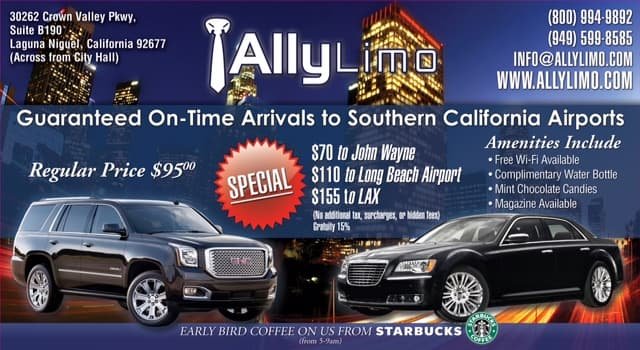What happened to Amazon Limo Service? Despite its initial promise, the venture ultimately fizzled out due to unforeseen challenges and market competition. With the rise of app-based ride-hailing services, such as Uber and Lyft, the demand for traditional limo services dwindled. Factors like convenience, affordability, and adaptability were key factors that led to the downfall of Amazon’s attempt to break into this industry.
Amazon Limo Service aimed to capitalize on the growing luxury transportation market by offering an exclusive and reliable service. However, the company failed to keep up with the rapidly evolving demands of consumers seeking on-demand transportation. As a result, Amazon Limo Service struggled to attract and retain customers, leading to its ultimate demise. This serves as a reminder that in today’s dynamic business landscape, adaptation to changing customer preferences and staying ahead of the competition is paramount for success in any industry.
Curious about the fate of Amazon Limo Service? While there isn’t specific information on “What Happened to Amazon Limo Service?,” it’s important to note that Amazon has diversified its business in recent years. They are now primarily known for their e-commerce platform, cloud services, and smart devices. It’s possible that the limo service didn’t align with their core business strategies. However, Amazon continues to innovate and offer a wide range of services to its customers.

What Happened to Amazon Limo Service?
Welcome to our comprehensive article on the story of Amazon Limo Service and its sudden disappearance from the transportation industry. In this piece, we will delve into the rise and fall of this once-prominent company, examining the factors that led to its demise and the impact it had on the market. From its inception to its closure, we will explore the twists and turns that unfolded, leaving many wondering, “What happened to Amazon Limo Service?” Let’s dive in and unravel the mystery.
The Rise of Amazon Limo Service
Amazon Limo Service started in 2010 as a venture by the e-commerce giant, Amazon. The service aimed to provide luxurious and reliable transportation options to customers across the United States. With Amazon’s vast resources and customer base, the company quickly gained traction and became a significant player in the transportation industry. Their fleet of premium vehicles, professional chauffeurs, and seamless booking process attracted both business and leisure travelers.
The popularity of Amazon Limo Service soared due to the unbeatable convenience it offered. Customers could effortlessly book a luxurious ride using the Amazon app, taking advantage of the company’s already established logistics infrastructure. This integration allowed for smooth coordination between Amazon deliveries and transportation services. The competitive pricing, combined with the trust and reliability associated with the Amazon brand, gave the company a strong foothold in the market.
As Amazon Limo Service continued to expand its operations and solidify its reputation, many believed it was poised to disrupt the entire transportation industry. However, this promising trajectory took an unexpected turn, leading to the eventual downfall of the once-thriving service.
The Challenges Faced by Amazon Limo Service
Despite its initial success, Amazon Limo Service encountered a series of challenges that ultimately contributed to its demise. One of the primary obstacles the company faced was the fierce competition from well-established players in the transportation industry. Companies like Uber and Lyft dominated the market, offering affordable and convenient ride-hailing services that appealed to a wide range of customers. This posed a significant threat to the niche luxury market that Amazon Limo Service catered to.
Another key factor that impacted the downfall of Amazon Limo Service was the emergence of new regulations and licensing requirements in various cities. The transportation industry faced increasing scrutiny regarding safety regulations and driver vetting procedures. These strict guidelines, although essential for passenger safety, added complexity to Amazon Limo Service’s operations and increased costs.
Furthermore, the economic downturn caused by the global financial crisis of 2008 had a lasting effect on consumer behavior. Many individuals and businesses tightened their belts, opting for more economical transportation options instead of splurging on luxury services. This shift in demand further exacerbated the challenges faced by Amazon Limo Service.
Downfall and Discontinuation of Amazon Limo Service
Despite efforts to adapt and overcome the obstacles, Amazon Limo Service ultimately decided to discontinue its operations. The company made this decision in 2015, after five years in the transportation industry. The discontinuation left many customers and industry experts surprised, as the service had shown great promise and had built a loyal clientele.
Amazon Limo Service cited the aforementioned challenges, coupled with the changing market dynamics, as the primary reasons for its closure. The company felt that it could no longer effectively compete with the growing dominance of ride-hailing services like Uber and Lyft. The decision to discontinue the service was made to allocate resources to more profitable ventures within the Amazon ecosystem.
While the closure of Amazon Limo Service was undoubtedly disappointing for its loyal customers, it served as a reminder of the ever-evolving nature of the business world. The transportation industry, in particular, has witnessed rapid advancements and disruptive innovations that have reshaped the way people travel. However, the story of Amazon Limo Service remains a chapter in the industry’s history, reminding us of the challenges and opportunities that arise in an increasingly competitive landscape.
The Impact of Amazon Limo Service’s Discontinuation
The discontinuation of Amazon Limo Service had far-reaching implications for both customers and the transportation industry as a whole. Let’s explore the impact of this event in greater detail.
Customer Shift to Ride-Hailing Services
With the closure of Amazon Limo Service, many of its customers sought alternatives in the form of ride-hailing services like Uber and Lyft. These platforms provided a convenient and cost-effective solution for transportation needs, offering a wide range of vehicle options to suit various preferences and budgets.
The shift to ride-hailing services marked a significant change in customer behavior, with individuals embracing the ease and accessibility these platforms provided. Customers no longer needed to pre-book luxury rides; they could simply request a ride on demand and have a vehicle arrive at their location within minutes. This shift in expectations further fueled the growth of the ride-hailing industry, solidifying its position in the marketplace.
Ride-Hailing vs. Luxury Transportation
The closure of Amazon Limo Service highlighted the fundamental differences between ride-hailing services and luxury transportation. Ride-hailing services primarily focus on affordability, convenience, and accessibility, allowing individuals from all walks of life to access reliable transportation. On the other hand, luxury transportation services cater to a niche market, providing premium vehicles and professional chauffeurs for those seeking a high-end experience.
While Amazon Limo Service initially aimed to bridge these two segments, the competition and evolving market dynamics led to its discontinuation. Ultimately, customers were left with a choice between the convenience and affordability of ride-hailing services or the luxury and exclusivity of alternative providers in the market.
Lessons Learned for the Transportation Industry
The story of Amazon Limo Service serves as a valuable lesson for the transportation industry. It highlights the importance of adapting to changing market conditions and remaining vigilant in the face of fierce competition. Companies must continuously innovate and evolve to meet the dynamic needs and preferences of customers.
Additionally, the rise and fall of Amazon Limo Service showcase the significance of understanding market trends and regulatory frameworks. Compliance with safety regulations and staying up to date with licensing requirements is crucial for the longevity and success of any transportation service.
No matter the fate of any individual company, the transportation industry will always be a landscape of constant change and evolution. Only those that can adapt and embrace new trends will thrive in this competitive arena.
Looking Beyond the Horizon
The future of the transportation industry holds numerous possibilities. As the demand for convenient and affordable transportation continually expands, innovative solutions will emerge. Let’s explore three potential trends that may shape the future of the transportation industry.
Autonomous Vehicles: Revolutionizing the Market
Autonomous vehicles, also known as self-driving cars, have the potential to revolutionize the transportation industry. With advancements in artificial intelligence and sensor technology, companies are actively developing vehicles that can navigate roads without human intervention.
Autonomous vehicles have the potential to enhance road safety, reduce traffic congestion, and optimize fuel efficiency. They may also disrupt the current dynamics of the transportation industry, as they eliminate the need for human drivers and could provide more affordable and efficient transportation options.
However, the widespread adoption of autonomous vehicles still faces regulatory, technological, and public trust challenges. As these hurdles are overcome, we can expect to see autonomous vehicles playing a more significant role in the transportation landscape.
Shared Mobility: Embracing Collaboration
Shared mobility models, such as carpooling and micro-transit, are gaining traction as an efficient and sustainable transportation solution. These models allow multiple passengers to share a vehicle heading in the same direction, reducing congestion and optimizing resource utilization.
Ride-hailing services have already embraced shared mobility through carpooling options, encouraging passengers traveling in similar directions to share rides. Additionally, micro-transit services offer on-demand transportation in smaller vehicles, catering to specific neighborhoods or communities.
Shared mobility models have the potential to reduce the number of cars on the road, decrease emissions, and provide cost-effective transportation solutions for passengers. As cities continue to prioritize sustainability and efficient urban planning, shared mobility is likely to become an integral part of transportation networks.
Electric and Sustainable Transportation
In recent years, there has been a growing emphasis on sustainable transportation options. Electric vehicles, powered by renewable energy sources, have gained popularity for their reduced carbon footprint compared to traditional gasoline-powered vehicles.
The increasing availability of electric charging infrastructure and the continuous improvement of battery technology have made electric vehicles a viable and attractive option for many consumers. Governments around the world are also implementing initiatives and incentives to encourage the adoption of electric vehicles, further driving their growth.
As concerns about climate change intensify, the push for sustainable transportation will continue to shape the industry. The integration of electric vehicles into ride-hailing and public transportation fleets will pave the way for a greener and more environmentally friendly future.
Conclusion
In this article, we explored the rise and fall of Amazon Limo Service, understanding the challenges it faced and the impact of its discontinuation. The story of Amazon Limo Service serves as a reminder of the dynamic nature of the transportation industry and the need for constant adaptation and innovation.
Furthermore, we looked beyond the horizon and explored potential trends that may shape the future of the transportation industry. From autonomous vehicles to shared mobility and sustainable transportation, the industry is poised for significant advancements.
As we move forward, it is vital for industry players to stay ahead of the curve, anticipate changing consumer preferences, and embrace new technologies. By doing so, they can thrive in an ever-evolving landscape and provide innovative solutions that meet the diverse needs of customers.
Key Takeaways: What Happened to Amazon Limo Service?
- Amazon used to offer a luxury limo service but later discontinued it.
- The service was called Amazon Limo and aimed to provide transportation for VIP customers.
- It is speculated that the high costs and low demand led to the discontinuation of the service.
- Amazon is known for experimenting with various business ventures, and the limo service may have just been one that didn’t work out.
- Although Amazon Limo is no longer available, Amazon continues to offer other transportation options, such as Prime Now delivery and Amazon Flex.
Frequently Asked Questions
What happened to the Amazon Limo Service?
1. Why did Amazon discontinue its limo service?
Amazon made the decision to discontinue its limo service in order to focus on its core business operations. The company recognized that its main expertise lies in e-commerce and delivering packages, rather than providing transportation services. By discontinuing the limo service, Amazon can allocate its resources more effectively to meet the growing demands of its customers and maintain its competitive edge in the market.
Additionally, Amazon likely realized that there are already established ride-sharing services, such as Uber and Lyft, that are better equipped to handle transportation needs. By partnering with these existing services, Amazon can still offer transportation options to its customers without the need to maintain a separate limo service.
2. How long did the Amazon Limo Service operate?
The Amazon Limo Service operated for a limited period of time before it was discontinued. Although the specific duration may vary, it is estimated that the service was available for a few years. During this time, Amazon explored the potential of expanding its business to include transportation services, but ultimately decided to focus on its core operations instead.
While the Amazon Limo Service may no longer be available, it is worth noting that Amazon continues to explore new ventures and expand its services in various industries. This demonstrates the company’s innovative spirit and willingness to explore new opportunities.
3. Did Amazon face any challenges with the limo service?
Like any new venture, the Amazon Limo Service faced its share of challenges. One of the main challenges was likely the competitive landscape. The transportation industry is already saturated with well-established players, making it difficult for Amazon to carve out a significant market share. Additionally, transportation regulations and licensing requirements can also pose challenges for companies entering the industry.
Furthermore, managing and maintaining a fleet of limos requires significant resources and expertise. Amazon may have recognized that it would require substantial investments in infrastructure and operations to compete effectively in the transportation market, which may not have aligned with its long-term business strategy.
4. Are there any alternative transportation options offered by Amazon?
Although Amazon discontinued its limo service, the company has partnered with various ride-sharing services to offer transportation solutions to its customers. Through partnerships with companies like Uber and Lyft, Amazon customers can conveniently book rides directly through the Amazon app. This allows customers to seamlessly integrate transportation options into their overall shopping experience.
By leveraging established ride-sharing platforms, Amazon is able to provide reliable transportation services without the need to maintain its own fleet or infrastructure. This approach allows Amazon to focus on its core business while still meeting the transportation needs of its customers.
5. Will Amazon ever re-launch its limo service?
As of now, there is no definitive information on whether Amazon will re-launch its limo service. However, it is essential to note that Amazon is known for its ability to innovate and adapt to changing market conditions. While the limo service may have been discontinued for strategic reasons, Amazon might explore other transportation-related endeavors in the future.
Regardless of the specific services offered, Amazon’s commitment to providing an exceptional customer experience remains unwavering. Whether it’s through partnerships with existing providers or the launch of new services, Amazon will continue to prioritize customer satisfaction and convenience.





